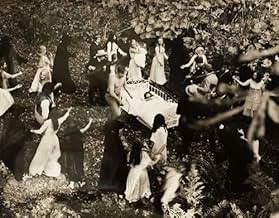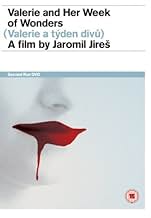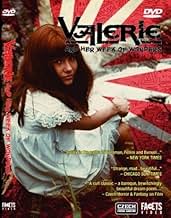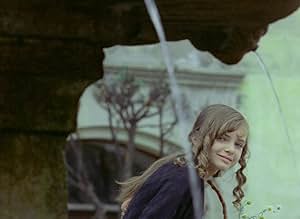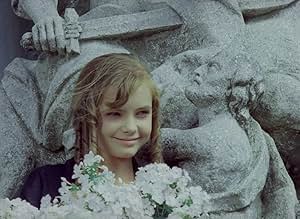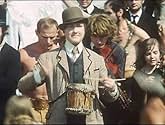IMDb-BEWERTUNG
7,0/10
12.485
IHRE BEWERTUNG
Inspiriert von Märchen wie Alice im Wunderland und Rotkäppchen, ist ein surreales Märchen, in dem Liebe, Angst, Sex und Religion zu einer fantastischen Welt verschmelzen.Inspiriert von Märchen wie Alice im Wunderland und Rotkäppchen, ist ein surreales Märchen, in dem Liebe, Angst, Sex und Religion zu einer fantastischen Welt verschmelzen.Inspiriert von Märchen wie Alice im Wunderland und Rotkäppchen, ist ein surreales Märchen, in dem Liebe, Angst, Sex und Religion zu einer fantastischen Welt verschmelzen.
- Auszeichnungen
- 1 Gewinn & 1 Nominierung insgesamt
Josef Abrhám
- Orlík
- (Synchronisation)
- (Nicht genannt)
Jana Andresíková
- Sluzka z vykriceného domu
- (Nicht genannt)
Alice Auspergerová
- Sluzka
- (Nicht genannt)
Empfohlene Bewertungen
An aimless but fascinating surreal fantasy a sort of adult-oriented version of 'Alice In Wonderland' with a distinctly Eastern European flavor VALERIE AND HER WEEK OF WONDERS was a revelation for me, and I am very glad I went the extra mile to acquire a copy of it on VHS.
The narrative makes little sense and, like I said, it does not lead to anywhere in particular, but the film's trump card is the incredible (and often poetic) beauty of its images. The film ostensibly deals with the sexual awakening of a teenage girl, though the way director Jaromil Jires goes about this is extremely complex yet effortlessly captivating, and very enjoyable to boot. It takes in a variety of dazzling psycho-sexual concepts drawn from religion and mythological folklore which come off as both inextricably modern and deeply provocative still.
The film features a number of sexual perversions throughout, which is pretty amazing when considering that the lead actress was only 13 years old at the time (though nothing too explicit is ever shown): she is involved in lesbianism, incestuous/Oedipal familial relationships, and is even subjected to an attempted rape by a young priest apart from being shown in various states of undress! In this way, it would seem to cater to the tastes of practically every broad-minded film-goer one can think of (be it art-house, horror or erotica), though it is arguable how well-known this film really is which is a pity.
The few elements we find here of the traditional horror film are worth expanding upon, however: we get a number of vampires (the leading member bears an unmistakable resemblance to the Max Schreck of NOSFERATU [1922]) who periodically revert to their formerly more human and youthful selves, if only to further disorientate Valerie and ensnare her in their volatile and greedy schemes. Finally we 'witness' Valerie being burned alive at the stake (as a witch), a punishment instigated by the same priest who had earlier seduced her. Still, she manages to emerge unscathed from her every crisis, thanks to a special talisman (in the shape of a pair of earrings) and the help of her goofy but devoted brother/lover, who goes by the name of Eagle!
Jaroslava Schallerova, who plays Valerie, is lovely and utterly charming throughout, striking a perfect balance between wide-eyed innocence and a curious sexual urge. Photography, sets, costumes and make-up are all wonderful (if obviously done on a low budget) - and the accompanying choral music is beautiful indeed, almost ethereal.
The by-now deleted Redemption PAL tape presented the film in a full-screen format (I'm not sure if this is the correct ratio or not); the print was far from pristine but perfectly acceptable for an obscure item such as this. I wonder who owns the U.S. rights, as I would love to see it get a much-deserved renaissance on DVD.
I cannot say whether VALERIE AND HER WEEK OF WONDERS was actually a one-off for this Czech film-maker, as I know very little about his other work. The only Jaromil Jires film available anywhere at the moment is THE JOKE (1969), by way of a reportedly substandard edition from Facets Video on VHS and DVD.
The narrative makes little sense and, like I said, it does not lead to anywhere in particular, but the film's trump card is the incredible (and often poetic) beauty of its images. The film ostensibly deals with the sexual awakening of a teenage girl, though the way director Jaromil Jires goes about this is extremely complex yet effortlessly captivating, and very enjoyable to boot. It takes in a variety of dazzling psycho-sexual concepts drawn from religion and mythological folklore which come off as both inextricably modern and deeply provocative still.
The film features a number of sexual perversions throughout, which is pretty amazing when considering that the lead actress was only 13 years old at the time (though nothing too explicit is ever shown): she is involved in lesbianism, incestuous/Oedipal familial relationships, and is even subjected to an attempted rape by a young priest apart from being shown in various states of undress! In this way, it would seem to cater to the tastes of practically every broad-minded film-goer one can think of (be it art-house, horror or erotica), though it is arguable how well-known this film really is which is a pity.
The few elements we find here of the traditional horror film are worth expanding upon, however: we get a number of vampires (the leading member bears an unmistakable resemblance to the Max Schreck of NOSFERATU [1922]) who periodically revert to their formerly more human and youthful selves, if only to further disorientate Valerie and ensnare her in their volatile and greedy schemes. Finally we 'witness' Valerie being burned alive at the stake (as a witch), a punishment instigated by the same priest who had earlier seduced her. Still, she manages to emerge unscathed from her every crisis, thanks to a special talisman (in the shape of a pair of earrings) and the help of her goofy but devoted brother/lover, who goes by the name of Eagle!
Jaroslava Schallerova, who plays Valerie, is lovely and utterly charming throughout, striking a perfect balance between wide-eyed innocence and a curious sexual urge. Photography, sets, costumes and make-up are all wonderful (if obviously done on a low budget) - and the accompanying choral music is beautiful indeed, almost ethereal.
The by-now deleted Redemption PAL tape presented the film in a full-screen format (I'm not sure if this is the correct ratio or not); the print was far from pristine but perfectly acceptable for an obscure item such as this. I wonder who owns the U.S. rights, as I would love to see it get a much-deserved renaissance on DVD.
I cannot say whether VALERIE AND HER WEEK OF WONDERS was actually a one-off for this Czech film-maker, as I know very little about his other work. The only Jaromil Jires film available anywhere at the moment is THE JOKE (1969), by way of a reportedly substandard edition from Facets Video on VHS and DVD.
Beautiful, disturbing, erotic, dreamlike... These are a few words that can sum up Jaromil Jires' deliriously bizarre fairy tale "Valerie and her Week of Wonders". Just like Richard Blackburn's sinister "Lemora", "Valerie" is a 'coming of age' tale told through a monstrous metaphor: vampires, who prey on the young to drain their innocence. Despite similarities theme-wise, these two films are quite different, and "Valerie" is certainly the most interesting of the two - a film that will definitely haunt you for life, with images so shocking today as they were back in 70's when it was released. It is 'horror' of rare ethereal beauty and poetry, and definitely one of it's kind - perfectly capturing the fear, the curiosity and the pleasure of a little girl's sexual awakening. Jaroslava Schallerová is spellbinding as the title character - a combination of Lewis Caroll's Alice and Vladimir Nabokov's Lolita. Helena Anýzová also gives a harrowing performance in the role of the grandmother, and her gradual transition from repressed Catholic old lady to a seductive, sex-crazed vampire is exquisite. Last but not least, Jires' excellent direction and Jan Curik's lush cinematography that highlights the film's "fever dream" tone help create this brilliant work of art that captures the essence of the ethereal and lyricism on celluloid unlike any other.
This is the best "girl gets her period" film I've ever seen. The week she comes of age, Valerie sees sex through many lenses. It is a very confusing time for her, full of danger and sensuality.
The film makes great use of color and music. The entire feature has a dreamy quality, not least because of the relentless and uneven symbolic representations. This film should be shown to every teenage girl, who should then go back and watch it again and again as she ages.
The film makes great use of color and music. The entire feature has a dreamy quality, not least because of the relentless and uneven symbolic representations. This film should be shown to every teenage girl, who should then go back and watch it again and again as she ages.
The lovely and enchanting Jaroslava Schallerova stars as the title character, a girl on the verge of womanhood. She exists in a medieval fantasy land where such things as vampires and witches can exist. She seeks to learn the truth about her parentage, encountering a rich variety of characters. Among them are the likable, well-meaning Eaglet and the creepy "man" known as The Polecat.
This won't appeal to everybody; some viewers may believe it to be too "arty". But it's richly rewarding for those looking for an unconventional take on genre fare. Drawing inspiration from fairy tales such as "Alice in Wonderland" and "Little Red Riding Hood", director Jaromil Jires draws us into an intoxicating atmosphere. Music, costumes, and sets are all absolutely breathtaking. Jires dares to take his time with the pacing, yet his film runs a scant 77 minutes. It touches upon such subjects as innocence (and the loss of same), jealousy, vanity, sex, religion, and decadence. Viewers should be aware, however, that despite the presence of elements such as vampires and witches, that this is anything but a typical horror film.
Extremely well acted, heartfelt, and thoughtful, this is an interesting entertainment. It would play very well as part of a double feature with the American film "Lemora: A Child's Tale of the Supernatural". It may not have much in the way of gore or nudity, but it doesn't need these things to make an impact.
Eight out of 10.
This won't appeal to everybody; some viewers may believe it to be too "arty". But it's richly rewarding for those looking for an unconventional take on genre fare. Drawing inspiration from fairy tales such as "Alice in Wonderland" and "Little Red Riding Hood", director Jaromil Jires draws us into an intoxicating atmosphere. Music, costumes, and sets are all absolutely breathtaking. Jires dares to take his time with the pacing, yet his film runs a scant 77 minutes. It touches upon such subjects as innocence (and the loss of same), jealousy, vanity, sex, religion, and decadence. Viewers should be aware, however, that despite the presence of elements such as vampires and witches, that this is anything but a typical horror film.
Extremely well acted, heartfelt, and thoughtful, this is an interesting entertainment. It would play very well as part of a double feature with the American film "Lemora: A Child's Tale of the Supernatural". It may not have much in the way of gore or nudity, but it doesn't need these things to make an impact.
Eight out of 10.
Exquisite aesthetic is not enough for me, especially in itself. I want layered stratagems, nested worlds, the built of an oblique carpentry, the stuff that Lynch deals in, Wojciech Has, Ruiz; or a unified space impregnated with those things, as in the films of Antonioni or Resnais. I want magic, the spontaneous and impromptu, to well up from a familiar view of life, poetry from mundane essentials, for example the scenes of Tokyo roads in Solyaris is the most amazing rite of passage I have seen. It's passage from a tangible world.
With something like this I have no point of entry. There is no double perspective, or one foot in a world that matters. It's one long psychosexual dream stirred up from restless sleep, a young girl's guilt nightmare of a throbbing sexuality.
Life inside the grandmother's house is sterile, but outside it booms with activity and rigor. Of course once out there, the adult world poses a constant threat; its web of dark, barely comprehensible forces - none too subtly dressed up in monk garbs, there's also a demonic figure in black who addresses from the pulpit a congregation of fearful maidens - out to drink life from youth. The film appropriates suitable imagery from the vampire film.
So even though the artistry is excellent, the nightmare effective, I am just not at all interested in teasing out symbolic detail from a rural pageant. There is this one layer, and the most pressing question for the film seems to be how much of that is a dream. But again, something hardly worth puzzling over.
This is a problem in general with the surreal part of the Czech school; while inventive craftsmen, they cannot seem to layer their narratives around a solid, penetrating core. So we get beautiful but scattershot imagination. On the other hand, their comedies are superb for the same reason.
With something like this I have no point of entry. There is no double perspective, or one foot in a world that matters. It's one long psychosexual dream stirred up from restless sleep, a young girl's guilt nightmare of a throbbing sexuality.
Life inside the grandmother's house is sterile, but outside it booms with activity and rigor. Of course once out there, the adult world poses a constant threat; its web of dark, barely comprehensible forces - none too subtly dressed up in monk garbs, there's also a demonic figure in black who addresses from the pulpit a congregation of fearful maidens - out to drink life from youth. The film appropriates suitable imagery from the vampire film.
So even though the artistry is excellent, the nightmare effective, I am just not at all interested in teasing out symbolic detail from a rural pageant. There is this one layer, and the most pressing question for the film seems to be how much of that is a dream. But again, something hardly worth puzzling over.
This is a problem in general with the surreal part of the Czech school; while inventive craftsmen, they cannot seem to layer their narratives around a solid, penetrating core. So we get beautiful but scattershot imagination. On the other hand, their comedies are superb for the same reason.
Wusstest du schon
- WissenswertesJaroslava Schallerová met the love of her life, Petrem Poradou, during the making of this film. Her mother was present on the set throughout the entire shooting of this movie.
- PatzerSeveral times throughout the movie people are picking up musical instruments and music is heard as if they are playing them but the fingerings don't match up with the notes, or sometimes no hand manipulation is done at all, just the appearance of playing the instrument. In one case, Eaglet is playing the flute and plays it horizontally when it is the vertical kind.
- VerbindungenFeatured in Resurrecting the Avant-Garde (2015)
Top-Auswahl
Melde dich zum Bewerten an und greife auf die Watchlist für personalisierte Empfehlungen zu.
- How long is Valerie and Her Week of Wonders?Powered by Alexa
Details
- Erscheinungsdatum
- Herkunftsland
- Sprache
- Auch bekannt als
- Valerie en la semana de los horrores
- Drehorte
- Produktionsfirma
- Weitere beteiligte Unternehmen bei IMDbPro anzeigen
Zu dieser Seite beitragen
Bearbeitung vorschlagen oder fehlenden Inhalt hinzufügen

Oberste Lücke
By what name was Valerie - Eine Woche voller Wunder (1970) officially released in India in English?
Antwort

